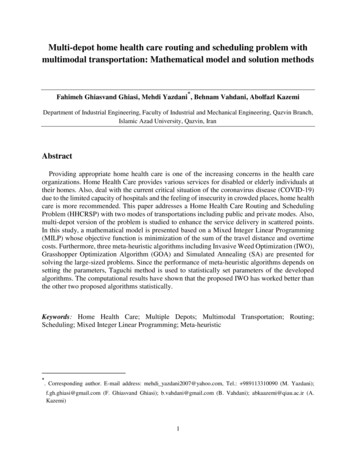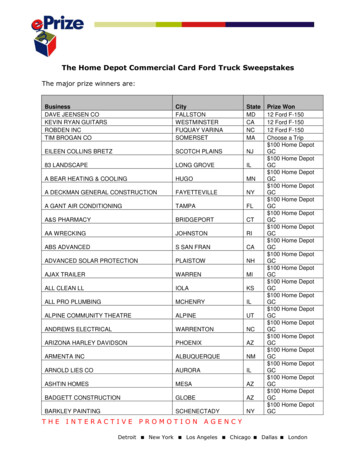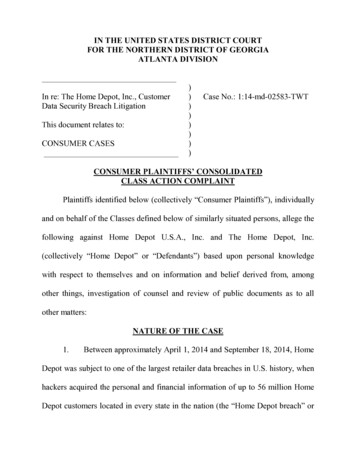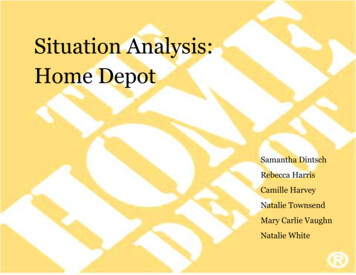
Transcription
Multi-depot home health care routing and scheduling problem withmultimodal transportation: Mathematical model and solution methodsFahimeh Ghiasvand Ghiasi, Mehdi Yazdani*, Behnam Vahdani, Abolfazl KazemiDepartment of Industrial Engineering, Faculty of Industrial and Mechanical Engineering, Qazvin Branch,Islamic Azad University, Qazvin, IranAbstractProviding appropriate home health care is one of the increasing concerns in the health careorganizations. Home Health Care provides various services for disabled or elderly individuals attheir homes. Also, deal with the current critical situation of the coronavirus disease (COVID-19)due to the limited capacity of hospitals and the feeling of insecurity in crowded places, home healthcare is more recommended. This paper addresses a Home Health Care Routing and SchedulingProblem (HHCRSP) with two modes of transportations including public and private modes. Also,multi-depot version of the problem is studied to enhance the service delivery in scattered points.In this study, a mathematical model is presented based on a Mixed Integer Linear Programming(MILP) whose objective function is minimization of the sum of the travel distance and overtimecosts. Furthermore, three meta-heuristic algorithms including Invasive Weed Optimization (IWO),Grasshopper Optimization Algorithm (GOA) and Simulated Annealing (SA) are presented forsolving the large-sized problems. Since the performance of meta-heuristic algorithms depends onsetting the parameters, Taguchi method is used to statistically set parameters of the developedalgorithms. The computational results have shown that the proposed IWO has worked better thanthe other two proposed algorithms statistically.Keywords: Home Health Care; Multiple Depots; Multimodal Transportation; Routing;Scheduling; Mixed Integer Linear Programming; Meta-heuristic*. Corresponding author. E-mail address: mehdi yazdani2007@yahoo.com, Tel.: 989113310090 (M. Yazdani);f.gh.ghiasi@gmail.com (F. Ghiasvand Ghiasi); b.vahdani@gmail.com (B. Vahdani); abkaazemi@qiau.ac.ir (A.Kazemi)1
1. IntroductionHome Health Care (HHC) services present specialized and general medical care for elderly anddisabled ones who need continuous nursing care at their homes. Currently, a vast number ofmedical and nursing companies are working in this field [1, 2]. Uncontrolled growth of industrialpollution as well as urban transportation system, have led to a raise in hospitalization. Althoughthe hospital offers specialized services, the congestion of hospitals is inconsistent with providinghigh quality services. The lower patients be in the hospital, the better nurses will be able to takecare of them. On the other hand, patients who need general hygiene cares feel more comfortableat home [3]. Also, with the advent of the coronavirus it's better for high risk people or patients withmild symptoms of this disease to get required medical services at home. Moreover, in cases whereCOVID-19 patients are in recovery phase some patients can leave the hospital and continuetreatment at home.Since the HHC goes back to public welfare and health, there are many important challengingdilemmas in this area such as Home Health Care Routing and Scheduling Problem (HHCRSP).Urbanization made nursing companies more eager to find the best route and schedule for nursessystematically. The HHCRSP is defined as planning and directing nurses to provide cares orservices at patients’ homes. It is developed form of Vehicle Routing Problem (VRP) with timewindows. To the best of our knowledge, Fernandez et al. [4] are one of the first researchers thathave studied the HHCRSP. They examined the working day of the United Kingdom nurses andconsidered the travel time and service providing time in the presented model. Also, the authorsprovided a method to split up the country based on the allocation of nurses. Begur et al. [5] hasaddressed a Spatial Decision Support System to plan HHC medical services.The HHCRSP can be divided into two categories: Single depot VRP [6, 7, 8] and multiple depotsVRP [1, 9, 10]. In single depot mode, nurses departure from a health center to patients’ home.Braekers et al. [6] developed the multi-objective single depot version of HHCRSP. They proposeda Mixed Integer Linear Programming (MILP) model for this problem and examined the tradeoffbetween cost and customer dissatisfaction objectives. The model considered characteristics suchas overtime [11, 12], travel costs depending on the mode of transportation, hard time window andclient preferences. In their study, small sizes of problems were solved using epsilon constraintframework. Also, the meta-heuristic algorithm based on the multi-directional local searchframework and large neighborhood search was proposed to solve problem instances of realisticsize. In order to assessing urban transportation sustainability, Fikar and Hirsch [7] considered carand trip sharing concepts for the single depot HHCRSP. They also have enumerated walking andtrip sharing as an effective way to attain sustainability goals. In multiple depots subject, there aretwo approaches in the literature. In the first approach, each nurse’s home acts as a depot and in thesecond approach, nurses move from several HHC offices to patients’ homes and the destinationdepot will be at a final location , e.g. their home, office, hospital or laboratory [10]. Note that fartoo little attention has been paid to second approach of multiple depots. Decerle et al. [1] developeda mixed integer programming model for the multi-depot HHC. Each nurse had a hard time window2
and a special qualification level. Their planning horizon was daily and a meta-heuristic algorithmwas presented for the problem. Tohidifard et al. [10] addressed a HHCRSP with several depotsand time windows. They proposed a bi-objective mathematical model and four heuristics for GreenHome Health Care (GHHC) problem. GHHC was developed to get HHC closer to real world. Also,different types of transportation system were used in the research problem. Nowadays there are anincreasing demand for HHC services, so the world is facing with the growth of HHC servicedelivery organizations. Also, HHC organizations are developing their branches in cities andmetropolises. Often, the main HHC center is a hospital with full facilities. In addition to thishospital, some branches are stablished in different high demanded places to present services in ascattered manner. The task of the branches is to equip nurses with necessary items and direct themto the patients for doing needed services. So, we chose multiple depots mode to present and definethe problem in this article.Most articles in the HHC field have used single transportation mode and a few of them haveused multimodal transportation [13]. VRP literature tried to control environmental pollutants usingapproaches such as utilizing several vehicle types [9], different modes of transportation and carsharing [7]. Xiao and Konak [14] developed a MILP model with considering heterogeneousvehicles. In their research different types of transportation system have been used. These vehicletypes have different capacities and cost of transportation. In the present article, we focused on twomodes of transportation including public and private modes [15, 16] with homogeneous vehicletypes. Since most of researches model the HHC as a development of VRP, the travel distance costis considered as the primary objective function of the problem. Moreover, several studies of HHCinclude overtime [17] in their models.Even if all of three above mentioned subjects including overtime, multimodal transportation andmultiple depots are investigated in the HHC literature, few articles addressed all of themsimultaneously. In this study, a mathematical model is presented for the HHCRSP problem basedon a MILP whose objective function is minimization of the sum of the travel distance and overtimecosts. Also, second approach of multiple depots and multimodal transportation (public and privatemodes) are considered in developing this model. Therefore, this article considers overtime,multimodal transportation and multiple depots subjects at the same time in the presented problem.A review of the literature reveals that some authors provided exact methods for solving theHHCRSP. Liu et al.[18] presented a branch-and-price algorithm for the problem. Riazi et al. [19]developed a column generation-based gossip algorithm for a single depot HHCRSP which containssingle mode of transportation. Authors integrated the gossip algorithm with a local solver basedon column generation, which made it an effective algorithm for larger problem instances. Theobjective function of the problem was determined minimization of the total distance traveled byall of the caregivers. Despite the benefits of accurate methods, these methods are able to plan afew visits and a limited number of nurses per day. Since the HHCRSP belongs to NP-hard class[12], exact methods cannot tackle this problem within a reasonable amount of time. To overcomethis difficulty, most of studies have utilized meta-heuristic algorithms to solve the problem in the3
HHC literature. These meta-heuristics include population-based methods such as hybrid ant colonyalgorithm [20], variable neighborhood search [17] and Genetic Algorithm [21]. Hiermann et al.[12] generated the initial response by a random approach, then improved the quality of solutionwith four meta-heuristics. Also, Decerle et al. [22] developed the memetic algorithm for solvingthe HHCRSP and investigated impact analysis of workload balancing on the problem.Trautsamwieser et al. [17] solved the real size HHCRSP problems by heuristic-based variableneighborhood search. Also, Mankowska et al. [23] developed adaptive variable neighborhoodsearch meta-heuristic for the HHCRSP with interdependent services. Liu et al. [24] proposed anadaptive large neighborhood search heuristic for the vehicle routing problem with time windowsof nurses and patients and synchronized visits in the HHC industry. The problem objective functionwas determined minimization of the vehicles’ travel costs and fixed costs. In the present study, wepropounded three well-known meta-heuristics including Invasive Weed Optimization (IWO),Simulated Annealing (SA) and Grasshopper Optimization Algorithm (GOA) for solving theunderstudied problem. To the best of our knowledge, it is the first time that IWO and GOA metaheuristic algorithms are used to optimize the HHCRSP problem. The HHCRSP covers some of theproblems and challenges related to nursing companies in the real world. Mainly HHCRSPencompass two aspects of routing and scheduling. Therefore, studying and optimizing HHCRSPbring about a reduction in costs of both patients and HHC centers, service providing in a reasonabletime and also covering more patients in a day. According to the fact that the problem is NP-Hard,we tried to provide more efficient algorithms for solving this problem. The main highlights of thepaper are as follows: Presenting a suitable and validated mathematical model for the HHCRSP based on a MILP; Considering overtime, multimodal transportation (public and private modes) and multipledepots subjects at the same time and simultaneously in the presented problem; Developing SA, IWO and GOA meta-heuristic algorithms to optimize the HHCRSP; Presenting a new solution representation method for proposed meta-heuristic algorithms.The outline of the paper is as follows. In section 2, problem description is presented. Section 3introduces the new mathematical model for the studied problem. In section 4, presented metaheuristic approaches are described, also computational study results are provided in section 5.Finally, conclusion and future perspectives of our work are stated in section 6.2. Problem descriptionThe HHCRSP is developed on a directed graph G (V , Q) where V VpVsVe is theset of vertices representing patients’ nodes (V p ) , initial start depots (Vs ) and destination depot(Ve ) . Each nurse n N (N N1 , N2 ,., Nnmax ) has a service time ( sti ) for patient i. For each nursen, a time window [an , bn ] is defined, which specifies the lower and upper bound of the nurse totalactivity during a day. Maximum regular working time duration for each nurse n is rn and mn is4
maximum allowed daily working time duration for each nurse, rn mn . Therefore, total workingtime is limited and the overtime is allowed up to a determined cost of d n . Overtime is equal to thetime exceeding the maximum regular working day. Each nurse is able to provide specific servicesand is assigned to the patients according to his/her qualification level. Parameter qin determineswhether a nurse n is sufficiently qualified to visit patient i (qin 1) or not (qin 0) . In order to allnurses can go to initial start and destination depots, the values of q0n and q fn is set to 1. The arc set Q is characterized as Q (i, j, n) i V \ Ve , j V \ Vs , n N , i j, qin 1, q jn 1 . In theproblem of this article, it is assumed that a qualified nurse is predetermined by the management ofmedical centers to provide the required medical services for each patient (job). Therefore, eachnurse has a pre-selected set of patients who should only visit them, which should be considered inthe members of the set Q. In fact, the challenge of the presented article is related to a real-worldsituation in which patients have selected their own nurse based on their preferences and finalizedtheir request in a contract with the main health care center. For patient convenience a hard timewindow [ei , li ] is defined for each patient i. Nurses should wait if they arrive before the start oftime window. The nurses’ movements between the nodes are done by vehicles. In this study, twotypes of transportation including private (mode 1) and public (mode 2) modes are considered forused vehicles. The public transportation mode has fewer travel costs and higher travel time compared with private transportation mode. K K1 , K2 ,., Kkmax is the set for vehicles and U u1, u2 ,., ukmax is the set for modes of transportation related to vehicles. Since in theunderstudied problem, each nurse is assigned to one vehicle for trip, the number of nurses is equalto the number of available vehicles (nmax kmax ) . Each vehicle k K begins at one of the initialstart depots (initial depots), transports the nurse between patients’ nodes and ends at destinationdepot (final depot). Parameter ci , j ,u( k ) is the travel cost between nodes i and j by vehicle k undermode u( k ) and ti , j ,u( k ) travel time between nodes i and j by vehicle k under mode u( k ) . The valuesof these two parameters are computed based on the Euclidean distance between nodes andcoefficients of time and cost.The developed HHC problem has a daily planning horizon. At the beginning of each day, theproblem is solved according to the real situation, location of new patients and the nurse presence.Afterwards, each nurse can start their visits by assigned vehicle according to the scheduledsequence. In this study, customer is essentially a patient who needs specialized medical andnursing services at home. These services can include injections, changing a surgical wounddressing, removing stitches and other essential medical services. Nurses have multiple initialdepots and one final depot. In this problem initial depots are health centers which should beassigned to nurses for determining starting point and the final depot is a hospital. It should be notedthat all the health centers are organized and managed by a hospital. Nurses start their route from5
one of the health centers and finally come back to the hospital to deliver the blood sample andinfectious wastes such as syringe needles. The problem goal is to find the best schedule and routefor each nurse including:1. Selecting the initial start depots for nurses;2. Determining the sequence of the patients’ visitation for each nurse;3. Finding the mode of transportation for each nurse based on the route.Also, the problem objective function is sum of the travel distance and overtime costsminimization.In the following example, a problem is assumed wherein there are 6 patients, 3 nurses, 3vehicles, 2 initial centers and one final health care center. Vehicles K1 and K 3 are belonged totransportation mode 1 (private mode) and vehicle K 2 to transportation mode 2 (public mode). It ispredetermined that nurse1 ( N1 ) visits patient1 (V p1 ) and patient3 (V p 3 ) , nurse2 ( N 2 ) visitspatient2 (V p 2 ) and patient5 (V p 5 ) and nurse3 ( N3 ) visits patient4 (V p 4 ) and patient6 (V p 6 ) .Parameters values related to patients’ service times ( sti ) , time window of nurses an , bn and timewindow of patients ei , li , maximum regular working time (rn ) and maximum allowed dailyworking time (mn ) are shown in Table 1. The coordinates of nodes for this problem are generatedrandomly and travel distance is calculated by Euclidean distance method. Then, travel time andtravel cost are computed based on obtained Euclidean distance between nodes. Nurses’ routes,assigned vehicles to the nurses, travel time of nurses from one node to another node and patients’service time (in terms of minutes) related to one feasible solution of this problem are shown inFigure 1. The values of travel times are dependent on the transportation modes. In this graph thenurse’s route is illustrated from origin nodes to destination. The Gantt chart of this solution isshown in the Figure 2. In this chart, the vertical axis represents nurses whereas the horizontal axisrepresents time. The latest arrival time to final health center is 446.64 and it is belonged to nurseN 2 . Also, the objective function (sum of the travel distance and overtime costs) value related tothis solution is equal to 27126.129.[Please insert Table 1 about here][Please insert Figure 1 about here][Please insert Figure 2 about here]6
In this article, the assumption of the understudied problem are as follows: Nurses start their routes from different health centers (initial depots) but finally return to ahospital (final depot). In fact, each nurse is assigned to one health center and starts his/hertrip from it with essential equipment and medicines.Nurses visit several patients and finally deliver patients medical report, infectious needleand blood samples to a hospital.Each vehicle belongs to one transportation mode (private or public).Each nurse is assigned to exactly one vehicle and one mode of transportation.Every patient is assigned to a specific nurse based on the required service.Service times are considered for patients in different time intervals.The patients receive services within a hard time window.Traffic and unexpected events are not considered in the presented model.3. Mathematical modelIn this section, a MILP model is presented for the HHCRSP. The related sets, indices,parameters and variables are listed below. Then the mathematical formulation is presented.Indiceskni, jfIndex for vehiclesIndex for nursesIndex for all the nodesIndex for final depot (hospital)Sets NSet of nurses; N N1 , N2 ,., N nmaxKSet of vehicles; K K1 , K2 ,., KkmaxUSet of transportation mode; U u1, u2 ,., ukmaxVSet of vertices which is included Vp Vs VeVpSet of patients’ vertices; Vp Vp1 , Vp 2 ,., VpnpVsSet of initial depots; Vs VS1 , VS 2 ,., VSnsVeFinal depot set (set with one element)Set of arcsQ max max7
ParametersstiService time for patient inmaxNumber of nurseskmaxNumber of vehiclesnsmaxNumber of initial depots (health centers)npmaxNumber of patients[ei , li ]Lower and upper bound of patient i time window[an , bn ]Lower and upper bound of nurse n time windowMci , j ,u(k )Big numberTravel cost between nodes i and j by vehicle k under mode u( k )ti , j ,uTravel time between nodes i and j by vehicle k under mode u( k )rnMaximum regular working time duration for each nurse nmnMaximum allowed daily working time duration for each nurse n (rn mn )dnA cost of d n is incurred when working time is exceeded rn(k )Decision Variables:Yi , j ,nBinary variable taking value 1 if nurse n travels from node i to j; 0, otherwise.X i , j ,n ,kZ n,kBinary variable taking value 1 if the vehicle k transfers nurse n from node i to j; 0,otherwise.Binary variable taking value 1 if waiting until beginning of time window is necessary; 0,otherwise.Binary variable taking value 1 if vehicle k is assigned to nurse n; 0, otherwise.TiTime at which nurse arrives at node i (i Vp )Ti ,nTime at which nurse n leaves from initial depot i (i Vs )T f ,nTime at which nurse n arrives at final depotOnAmount of overtime done by nurse nWiUsing this information, the mathematical model for HHCRSP is as follows.Objective function:Min ci, j ,u( i , j , n ) Q k K(k )X i , j ,n,k dnOn(1)n8
Constraints: i , n ( i , j , n ) QYi , j ,n 1 i Vs j ( i , j , n ) QYi , j ,n 1 Yi , f ,n 1 Yi , j ,n i ( i , f , n ) Qj ( i , j , n ) Q j ( i , j , n ) Q j Vp(2) n N(3) n N(4) i Vp ; n NY j ,i ,n(5)Yi , j ,n X i , j ,n,k (i, j, n) Q(6) Z n,k 1 k K(7) Z n,k 1 n N(8)k Kn Nk KX i , j , n, k Z n,kTi sti (i, j, n) Q; k K n ( i , j , n ) QTi ,n ti , j ,u(k )ti , j ,u X i , j ,n,k T j M (1 (k ) n ( i , j , n ) Q T j M (1 X i , j ,n,k )Ti sti ti , f ,u(k )X i , j ,n,k ) i, j Vp ; k K (i, j, n) Q; i Vs ; j f ; k K T f ,n M (1 X i , f ,n,k ) (i, f , n) Q; i Vs ; k Kei Ti li i VpT j Ti,n ti , j ,u( k ) M (1 X i , j ,n,k )n(11)(12)(13)(14) (i, f , n) Q; i Vp ; k K(15) i, j Vp (i j )(16)T j Ti sti ti , j ,u( k ) X i , j ,n,k M (1 X i , j ,n,k W j )k(10) (i, j, n) Q; i Vs ; j Vp ; k KT f ,n Ti sti ti, f ,u( k ) M (1 X i, f ,n,k )n(9)kT j e j M (1 W j ) j Vpan T f ,n bn n N9(17)(18)
an Ti ,n bn i Vs ; n N(19)Tf ,n Ti ,n mn i Vs ; n N(20)On Tf ,n Ti.n rn i Vs ; n N(21)Yi, j ,n , X i, j ,n,k , Zn,k ,Wi (binary variables) and Ti , Ti,n , T f ,n , On (continuoues variables) 0(22)Objective function (1) minimizes the sum of the travel distance and overtime costs. Constraint (2)ensures that each patient should be visited only once by a qualified nurse. Constraints (3) and (4)ensure that each nurse journey starts at the initial depots and ends at final depot. Constraint (5)confirms that if nurse n enters a patient node then the nurse should leave that node to anotherallowed node. Constraint (6) shows the relationship between the Yi , j ,n and X i , j ,n,k decisionvariables. This constraint indicates that each nurse n should travel from node i to node j by exactlyone vehicle. Binary variable Yi , j ,n taking value 1 if nurse n travels from node i to j; Also, binaryvariable X i , j ,n,k taking value 1 if the vehicle k transfers nurse n from node i to j. We used thisconstraint to establish reasonable relationship between these variables and ensure transportationof each nurse by only one vehicle. Constraints (7) and (8) ensure that each nurse use only onevehicle and also each vehicle is assigned to only one nurse. Binary variable Z n,k taking value 1 ifvehicle k is assigned to nurse n, so Constraint (9) states that if nurse n travels from node i to nodej by vehicle k, then nurse n is definitely assigned to that vehicle. Because if vehicle k is not assignedto nurse n ( Z n,k 0 ), then X i , j ,n,k 0 and nurse n cannot transfer from node i to node j by vehiclek. Constraint (10) indicates that the arrival time to node j ( j Vp ) is greater or equal than thearrival time to node i (i Vp ) in addition to the service delivery time of node i as well as traveltime between two nodes. According to constraint (11), no flow is established directly from originnodes to destination. Constraint (12) shows the accuracy of arriving time to final depot. Constraint(13) guarantees that each patient service delivery is started within its time window. Constraint (14)states that if nurse n is moved between initial depot i (i Vs ) and node j ( j Vp ) by vehicle kunder mode u( k ) , maximum arriving time to node j is equal to time of leaving initial depot inaddition to travel time between two nodes. Constraint (15) illustrates that maximum arriving timeto final depot is equal to arriving time to the last patient node in addition to the time of servicedelivery in that node as well as travel time between the last patient and final depot. Based onconstraint (16), maximum arriving time to node j is equal to arriving time to previous node inaddition to the time of service delivery in previous node as well as travel time between two nodes.In this constraint, if nurse n travels from node i to node j by vehicle k then X i , j ,n,k is equalnkto 1. Existence of big number M becomes dependent on the existence of W j . So, if waiting time10
for node j exists (W j 1) , big number M disables the given constraint. But if there is no waitingtime, this constraint works. According to constraint (17), if patient time window is started, waitingtime is not allowed and the service must be done for the patient by the assigned nurse withoutdelay. In fact, arriving time of the nurse to node j (T j ) is limited up to patient time window becausedelay is a waste of time for both nurse and patient. So, if waiting is occurred, the activity can notto start later than time window and delay is not allowed. In fact, waiting times within the timewindow are prohibited by constraints (14-17). Constraint (18) and (19) make sure that caregiversare only allowed to work within a given time window. Constraint (20) ensures that maximumworking time is not exceeded and constraint (21) shows the overtime calculation. Equations (22)represent the decision variables domain.4. Meta-heuristic approachesDue to computational complexity, solving medium and large-sized HHCRSP in reasonable timeby exact methods is not possible. So, we have resorted to meta-heuristics to solve the problem. Inthe presented study, IWO [25], GOA [26] and SA [27] algorithms are presented for theoptimization process. In the following, solution representation method, neighborhood structureoperators, steps of utilized algorithms and parameter tuning of algorithms are described.4.1.Solution representationIn this paper, the solutions are illustrated in a multiple string format. A separate string isprovided for each nurse. Also, a vehicle string is considered wherein each nurse is assigned to onevehicle. In this new solution representation method, the initial depots of nurses, order of patients’visitation and the assigned vehicles are determined. To describe solution representation method,the feasible solution related to the defined problem of section 2 (as shown in Table 1) is considered.The representation of this solution is shown in Figure 3. This representation is included threestrings for determining nurses’ routs (nurses’ strings) and one for assigning vehicle (Vehiclestring). Two first cells of the nurses’ strings show the two initial depots and the larger one in termsof value is selected as initial center of nurse. The third and fourth elements are corresponded to thepatients who are assigned to the nurses. In decoding scheme, these two elements are arranged inascending order and patients’ visitation is done by the nurse according to it. Based on the firststring of solution representation, nurse 𝑁1 begins the route from initial depot Vs1 , visits V p1 andV p 3 respectively and finally goes to the final depot (Ve ) .Similarly, the path of other nurses is presented as separated strings in Figure 3. Furthermore,vehicle allocation to nurse should be specified. In Figure 3, the fourth string of solutionrepresentation shows the allocation of vehicles to the nurses based on vehicle number. Nurses’routes related to above example is illustrated in Figure 4. In the presented example, number ofpatients who are assigned to all nurses is equal. But sometimes different numbers of patients are11
assigned to nurses. As a result, it is not possible to consider solution representation in a matrixform. For example, the representation of one feasible solution from a problem with the unbalancedallocation of nurses to the patients is shown in Figure 5. In this figure the length of strings is notthe same. Nurses’ routes related to example of Figure 5 is illustrated in Figure 6.[Please insert Figure 3 about here][Please insert Figure 4 about here][Please insert Figure 5 about here][Please insert Figure 6 about here]4.2. Neighborhood structureTo improve the quality of solutions, the neighborhood structure operator is used for generatingneighboring solution from current solution. In this paper, four neighborhood structures, SwapNurse string operator, Regenerating-Nurse string operator, Swap-Vehicle string operator andReordering-Vehicle string operator are presented for creating neighboring solutions. We profitfrom the operators’ ideas presented by Nasir and Kuo [28] in developing the proposedneighborhood structures. To implement the neighborhood structures related to nurse string, onestring among nurses’ strings of the candidate solution is first chosen randomly. In Swap-Nursestring operator, two cells are selected from the nurse string at random and values of their locationsare substituted. In Regenerating-Nurse string operator, one point of the nurse string is chosenrandomly, then values from that point to the end of the string are regenerated. This operator maychange the left or right hand side of the selected point randomly. Therefore, Initial depot of thenurse and the order of patients’ visitation can be changed by these two operators. In Swap-Vehiclestring operator, two cells are selected from the vehicle string at random and values of theirlocations are replaced. Furthermore, Reordering-Vehicle string operator is implemented forvehicle string which in one po
The HHCRSP can be divided into two categories: Single depot VRP [6, 7, 8] and multiple depots VRP [1, 9, 10]. In single depot mode, nurses departure from a health center to patients' home. Braekers et al. [6] developed the multi-objective single depot version of HHCRSP.










